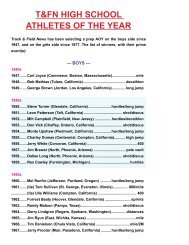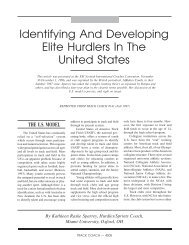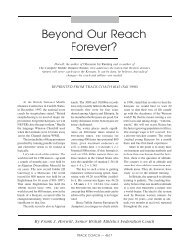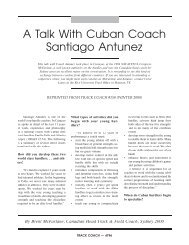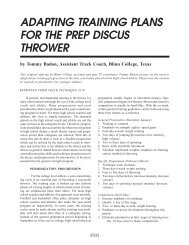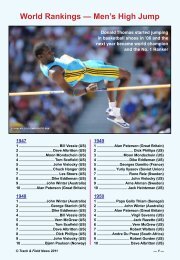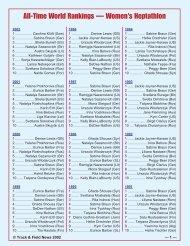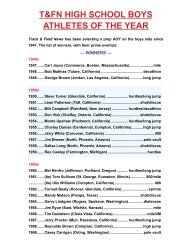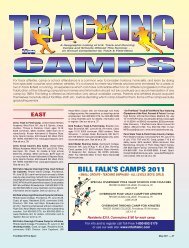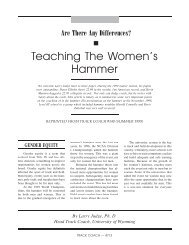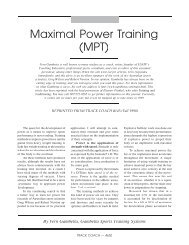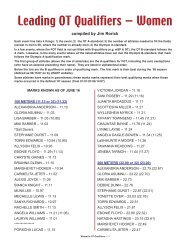SPEED TRAINING - Track & Field News
SPEED TRAINING - Track & Field News
SPEED TRAINING - Track & Field News
Create successful ePaper yourself
Turn your PDF publications into a flip-book with our unique Google optimized e-Paper software.
esult in increase of force against the ground, which can<br />
produce a longer stride or, more importantly, if more force<br />
can be created in less time, less ground contact time and<br />
greater stride frequency. (It is less ground contact time,<br />
and therefore greater stride frequency, which separates<br />
good and great sprinters 4 ).<br />
<strong>SPEED</strong> ENDURANCE <strong>TRAINING</strong><br />
Speed endurance—the ability to maintain high speed<br />
sprinting—has two metabolic facets: alactic speed endurance<br />
and lactic (glycolytic) speed endurance.<br />
These metabolic processes are not absolutely separable,<br />
and training the lactic system certainly trains the<br />
alactic system. The alactic system, or short speed endurance,<br />
predominates in exercise through the 200m. The<br />
lactic system, or long speed endurance, begins contributing<br />
to intense exercise after about 5 seconds, however, and<br />
probably becomes the dominant system between 10-20<br />
seconds of activity. 5<br />
Due to various reasons, we separate in training the<br />
groups of sprinters who are better at the 100-200m (the<br />
“short sprints”) from the 200-400m runners (the “long<br />
sprints”). This is due not only to the different energy<br />
demands between the two types of sprints, but also to<br />
reduce anxiety among short sprinters who dread training<br />
distances beyond 300m in length.<br />
Although these workouts vary with the cycle being<br />
used at the moment, short sprinters do repetitions of 100-<br />
300m, with volumes of 2-10, depending on the length of<br />
the work interval and its intensity (speed). 6 Long sprinters<br />
do repetitions of 150-600m, with volumes of 2-12, with<br />
the same considerations as the short sprinters.<br />
We categorize all of our speed endurance work as<br />
“interval” work, as there is a work interval (sprint) and<br />
recovery interval (rest) involved, rather than use the many<br />
other names (repetitions, extensive, intensive, etc.).<br />
Then, we categorize our interval work by the intensity<br />
(speed), duration (time or distance), and degree of<br />
total fatigue created by each work interval and the total<br />
workout. The volume of the workout is then determined<br />
by the contribution of each interval to the total fatigue of<br />
the lactic acid or alactic energy system.<br />
The workouts tend to fall into three categories, with<br />
some overlap:<br />
1. Low Anaerobic Stress Workouts, characterized by<br />
low to medium intensity, short to medium durations, low<br />
to medium stress or fatigue—they approach total fatigue<br />
slowly.<br />
These sprint workouts build up fatigue slowly, and are<br />
used with short recoveries between sprints (1-3 minutes,<br />
or 120 bpm heart rate). They are primarily used in the<br />
early cycles (prior to Christmas break), and may also be<br />
used for aerobic conditioning.<br />
Examples: 3-4x150, 3-4x100, 3-4x50 to 90% with<br />
1-2 min between reps, 2-4 min between sets; 8x200 with<br />
100 walk, 100 jog as rest (1-2 min) at about 28-30 sec<br />
each; 10x150 accelerations to 90%, 1-2 mm rest; 5-6x<br />
300 with 1-2 min rest, slow (48-54) 5x200 with 3 min<br />
rest, moderate (27-28); 6-12x400 fartlek (100 walk, 100<br />
jog, 100 stride—65-70 pace, 100 sprint—90%); 3-4x300-<br />
200 1 min between 300 and 200, 3-5 min between sets,<br />
approx. 48-50 and 27-29.<br />
2. Medium to High Anaerobic Stress Workouts, characterized<br />
by medium to high intensity, short to long durations,<br />
medium to high stress or fatigue—they approach<br />
total fatigue more quickly, each interval significantly<br />
contributing to total fatigue.<br />
These sprints are run at or near event race speeds, they<br />
build up fatigue quickly. Relatively complete recoveries<br />
(to 100 bpm HR) are used, as each interval contributes<br />
significantly to total fatigue. The recoveries may be long<br />
(10-30 minutes), or progressive (5-8 min, 8-12 min, 12-15<br />
min—longer with each proceeding work interval). Complete<br />
recoveries are used when doing these workouts near<br />
championship meets (in peaking/resting phases).<br />
Examples: 3-4x300 (5-8 min rest 39-44, depending<br />
on ability); 1x600, 1x500, 20-30 min rest, very fast (1:<br />
30-1:38; 72-75); 500-300-200, progressive rests (72-75;<br />
5-8 min; 39-42; 8-12 min; 24-25) or 500-300-200, progressive<br />
rests (72-75; 5-8 min; 39-42; 8-12 min; 24.25)<br />
or 500-300-200 with 5 min rests (76-80, 40-44, 25-27);<br />
3x200 at 99% with 10 min rests; 1x300, 10-20 min rest,<br />
1x200 at 99%; 300-300-200-200 with 5 min rests (40-43;<br />
25-27).<br />
3. High Anaerobic Stress Workouts, characterized<br />
by high intensity, medium to long durations, high to<br />
very high stress or fatigue—approach total fatigue very<br />
quickly—exhaustive workouts. These are very hard workouts<br />
and are not done in, or too near, a peaking phase<br />
(1 1 / 2-2 weeks before Conference Championship). They are<br />
meant to simulate 400m race stresses, and are not done<br />
more often then once a week (usually once every two<br />
weeks).<br />
Examples: 300-200 at race pace for 400 with 1 min<br />
rest, 20 min rest, repeat or 200-200; 1x500 at 99%, 20-<br />
30 min rest, 1x300 at 99%; 1x600 at 99-100%, go home;<br />
lx500 at 99-100%, go home. For the short sprinter—1 x200<br />
at 99%, 3x100 at 99%, 3x50 at 99% all with 5 minutes<br />
rest.<br />
In training speed endurance, we start with type 1<br />
workouts and blend in to type 2 workouts, done below<br />
(slower than) the ability of the athlete, in our cycles before<br />
Christmas break. After Christmas, we begin with type 2<br />
workouts, then add type 3 workouts when the athletes<br />
are ready for them. As we near championship meets, we<br />
eliminate the type 3 workouts and modulate the type 2<br />
workouts (more rest, more speed). We do the harder workouts<br />
near the beginning of the week. We treat meets as<br />
hard workouts and have an easy or rest day after them.<br />
3290



